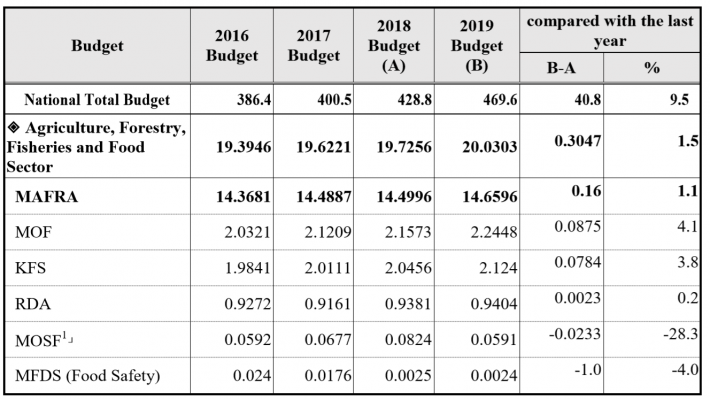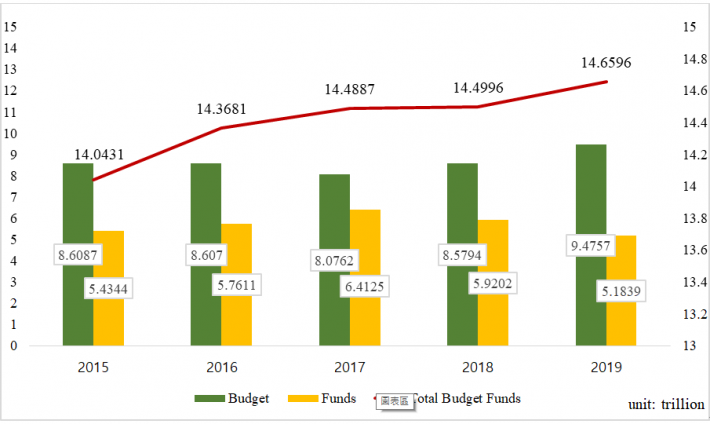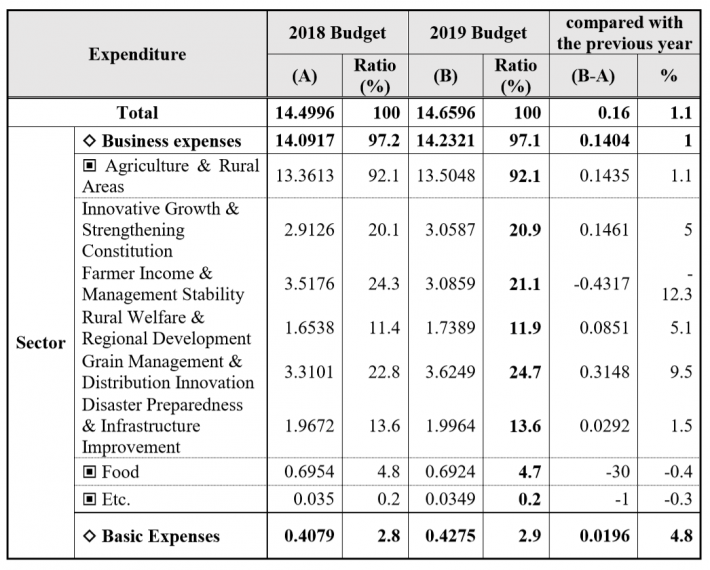INTRODUCTION
Government budget can be divided into budget and fund by the way it is managed. And there are two ways of financing a project: investment or lending. Government budget is divided into central government budget and local government budget, each of which can be subdivided into general account and special account. Since government budget in general refers to central government budget, our discussion here will center on central government budget.
A special account does not follow the principle of prohibiting the use of a budget for a specific purpose. It is a separate budget used to manage the operation of special policy programs. There are several special accounts in the agricultural sector. Public funds are linked even more strongly with specific programs and are managed separately by the agency responsible for the program. There are several funds operated by Ministry of Agriculture, Food and Rural Affairs (MAFRA). Included among them are the farmland management fund, the price stability fund for agricultural products, and the variable direct payment for rice income compensation.
For project expenditures other than the expenses incurred directly by the government, agricultural budgets are either utilized as direct investments by the government or related agencies or provided as loans to farmers. The loans for farmers are usually provided through agriculture related special accounts or funds, and are called policy loans. These funds are drawn from the national budget or commercial banks. The government sometimes only uses the method of compensating the interest rate gap between policy loan and commercial loan. This type of system places less burden on the government budget while providing low interest loans to a large number of users, and it softens the competitive relationship between policy loans and commercial loans.
STATUS OF THE 2019 AGRICULTURAL BUDGET IN KOREA
The total national budget for 2019 is about 469.6 trillion won (US$ 413.2 billion), which has increased about 9.5% compared with the last year budget, and among them, the amount of the budget for agriculture, forestry, fisheries and food sector is 20.03 trillion won (US$ 17.6 billion). The agriculture, forestry, fisheries and food sector consists of four Ministries departments which are Ministry of Agriculture, Food and Rural Affairs(MAFRA), Ministry of Oceans and Fisheries(MOF), Korea Forest Service(KFS), Rural Development Administration(RDA), Ministry of Strategy and Finance(MOSF), and the last, Ministry of Food and Drug Safety(MFDS).
The budget of the Ministry of Agriculture, Food and Rural Affairs (MAFRA) for 2019 was 14.6 trillion won (US$ 12.8 billion), up 1.1% (160 billion won) from 14.49 trillion won in 2018. MAFRA budget is 3.1% of the total national budget of Korean government.
Table. 1 Budget Status of the Agriculture, Forestry, Fisheries and Food Sector per Department
Unit: Trillion Won

1 lottery fund, national property management fund
General expenditure of the budget is 9.47 trillion won (US$ 8.31 billion dollars) which has increased 10% from 2018. General expenditure of the funds is 5.1839 trillion won (US$ 4.54 billion dollars) which has decreased 12.4% from 2018. The total expenditure reaches over 14 trillion won (US$ 12.8 billion dollars). The increase rate of the total expenditure in agriculture from 2015 to 2019 is nearly 1.1%, well below 5.8% increase in the overall government expenditure.
Table. 2 Budget Trend of MAFRA over the past 5 years (2015~2019)
Unit: Trillion Won

Figure. 1 Budget Trend of MAFRA over the past 5 years

From 2018 to 2019, the budgets were increased for innovative growth & strengthening constitution (5%), rural welfare & regional development (5.1%), grain management & distribution innovation (9.5%), and disaster preparedness & infrastructure improvement (1.5%).,While farmer income & management stability (-12.3%), food (-0.4%), etc. (-0.3%) were decreased.
Table3. Changes in the budget of MAFRA from 2018 to 2019

CONCLUSION
Although the national total budget has increased about 9.5% compared to the last year, the agricultural budget in 2019 has increased merely 1.5% more than last year. The portion of the agricultural budget in the national total budget, therefore, has also shrunk to 3.1% this year from 3.4% of the last year. People who engage in agriculture strongly criticize the government because of the little increase in the agricultural budget which is only 1.5% well below 9.5% increase in the total budget. They are also worried that the poor treatment on the agricultural budget will continue after next year.
REFERENCE
Overview of the Budget and Funds Management Plan of the Ministry of the Agriculture, Food and Rural Affairs http://www.mafra.go.kr/mafra/325/subview.do


2019 Agricultural Budget in Korea
INTRODUCTION
Government budget can be divided into budget and fund by the way it is managed. And there are two ways of financing a project: investment or lending. Government budget is divided into central government budget and local government budget, each of which can be subdivided into general account and special account. Since government budget in general refers to central government budget, our discussion here will center on central government budget.
A special account does not follow the principle of prohibiting the use of a budget for a specific purpose. It is a separate budget used to manage the operation of special policy programs. There are several special accounts in the agricultural sector. Public funds are linked even more strongly with specific programs and are managed separately by the agency responsible for the program. There are several funds operated by Ministry of Agriculture, Food and Rural Affairs (MAFRA). Included among them are the farmland management fund, the price stability fund for agricultural products, and the variable direct payment for rice income compensation.
For project expenditures other than the expenses incurred directly by the government, agricultural budgets are either utilized as direct investments by the government or related agencies or provided as loans to farmers. The loans for farmers are usually provided through agriculture related special accounts or funds, and are called policy loans. These funds are drawn from the national budget or commercial banks. The government sometimes only uses the method of compensating the interest rate gap between policy loan and commercial loan. This type of system places less burden on the government budget while providing low interest loans to a large number of users, and it softens the competitive relationship between policy loans and commercial loans.
STATUS OF THE 2019 AGRICULTURAL BUDGET IN KOREA
The total national budget for 2019 is about 469.6 trillion won (US$ 413.2 billion), which has increased about 9.5% compared with the last year budget, and among them, the amount of the budget for agriculture, forestry, fisheries and food sector is 20.03 trillion won (US$ 17.6 billion). The agriculture, forestry, fisheries and food sector consists of four Ministries departments which are Ministry of Agriculture, Food and Rural Affairs(MAFRA), Ministry of Oceans and Fisheries(MOF), Korea Forest Service(KFS), Rural Development Administration(RDA), Ministry of Strategy and Finance(MOSF), and the last, Ministry of Food and Drug Safety(MFDS).
The budget of the Ministry of Agriculture, Food and Rural Affairs (MAFRA) for 2019 was 14.6 trillion won (US$ 12.8 billion), up 1.1% (160 billion won) from 14.49 trillion won in 2018. MAFRA budget is 3.1% of the total national budget of Korean government.
Table. 1 Budget Status of the Agriculture, Forestry, Fisheries and Food Sector per Department
Unit: Trillion Won
1 lottery fund, national property management fund
General expenditure of the budget is 9.47 trillion won (US$ 8.31 billion dollars) which has increased 10% from 2018. General expenditure of the funds is 5.1839 trillion won (US$ 4.54 billion dollars) which has decreased 12.4% from 2018. The total expenditure reaches over 14 trillion won (US$ 12.8 billion dollars). The increase rate of the total expenditure in agriculture from 2015 to 2019 is nearly 1.1%, well below 5.8% increase in the overall government expenditure.
Table. 2 Budget Trend of MAFRA over the past 5 years (2015~2019)
Unit: Trillion Won
Figure. 1 Budget Trend of MAFRA over the past 5 years
From 2018 to 2019, the budgets were increased for innovative growth & strengthening constitution (5%), rural welfare & regional development (5.1%), grain management & distribution innovation (9.5%), and disaster preparedness & infrastructure improvement (1.5%).,While farmer income & management stability (-12.3%), food (-0.4%), etc. (-0.3%) were decreased.
Table3. Changes in the budget of MAFRA from 2018 to 2019
CONCLUSION
Although the national total budget has increased about 9.5% compared to the last year, the agricultural budget in 2019 has increased merely 1.5% more than last year. The portion of the agricultural budget in the national total budget, therefore, has also shrunk to 3.1% this year from 3.4% of the last year. People who engage in agriculture strongly criticize the government because of the little increase in the agricultural budget which is only 1.5% well below 9.5% increase in the total budget. They are also worried that the poor treatment on the agricultural budget will continue after next year.
REFERENCE
Overview of the Budget and Funds Management Plan of the Ministry of the Agriculture, Food and Rural Affairs http://www.mafra.go.kr/mafra/325/subview.do